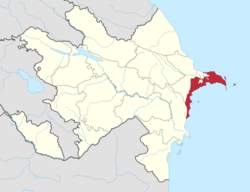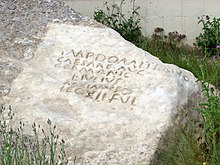Baku Economic Region
Baku Economic Region
Bakı Iqtisadi Rayonu | |
|---|---|
 Baku Economic Region in Azerbaijan | |
| Country | Azerbaijan |
| Established | 7 July 2021 |
| Area | |
| • Total | 2,140 km2 (830 sq mi) |
| Population (2021)[1] | |
| • Total | 2,300,500 |
| • Density | 1,100/km2 (2,800/sq mi) |
Baku Economic Region (Azerbaijani: Bakı Iqtisadi Rayonu (BIR)) is one of the 14 economic regions of Azerbaijan. It borders the economic region of Absheron-Khizi to the west and Caspian Sea to the east. The region consists of the city district of Baku, the capital of Azerbaijan.[2] It has an area of 2,140 square kilometres (830 sq mi). Its population was estimated to be at 2.3 million people in January 2021.[1]
History
[edit]Established
[edit]Baku Economic Region was established on 7 July 2021 as part of a reform of the economic region system of Azerbaijan. Its territory was part of the larger Absheron Economic Region prior to 2021.[3]
Antiquity
[edit]
Traces of human settlement in the region of present-day Baku date back to the Stone Age. Bronze-Age rock carvings have been discovered near Bayil, and a bronze figure of a small fish in the territory of the Old City. These have led some to suggest the existence of a Bronze-Age settlement within the city's territory.[4] Near Nardaran, a place called Umid Gaya features a prehistoric observatory, where images of the sun and of various constellations are carved into rock together with a primitive astronomic table.[5] Further archeological excavations have revealed various prehistoric settlements, native temples, statues and other artifacts within the territory of the modern city and around it.
In the 1st century AD, the Romans organised two Caucasian campaigns and reached what is today Baku. Near the city, in what is today Gobustan, Roman inscriptions dating from AD 84 to 96 survive – some of the earliest written evidences for a city there.[6]
According to the 6th-century archbishop and historian St. Sophronius of Cyprus, in 71, St. Bartholomew the Apostle was preaching Christianity in the city of Albana or Albanopolis,[7] associated with present-day Baku[8] or Derbent,[9] both located by the Caspian Sea. St. Bartholomew managed to convert even members of the local royal family who had worshipped the idol Astaroth, but was later martyred by being flayed alive and crucified head down on orders from the pagan king Astyages.[10] The remains of St. Bartholomew were secretly transferred to Mesopotamia.[11]
References
[edit]- ^ a b "Territories, number and density of population by economic and administrative regions of the Republic of Azerbaijan". The State Statistical Committee of the Republic of Azerbaijan. 2021. Retrieved 24 April 2022.
- ^ "New economic regions of Azerbaijan – LIST". Report News Agency. 7 July 2021. Retrieved 24 April 2022.
- ^ "Azərbaycan Respublikasında iqtisadi rayonların yeni bölgüsü haqqında Azərbaycan Respublikası Prezidentinin Fərmanı". president.az (in Azerbaijani).
- ^ Город Баку... Archived 19 March 2014 at the Wayback Machine Retrieved on 24 June 2006
- ^ Ancient Observatory of Absheron. Gobustan, No 3 (1973)
- ^ "Azerbaijan – Walled City of Baku with the Shirvanshah's Palace..." Archived from the original on 2 January 2008. Retrieved 14 October 2007.
- ^ The Works of Sophronius, Archbishop of Cyprus (1911). Tiflis. p.397.30
- ^ Bartholomew — Some Thoughts[permanent dead link]. The Parish of Upper Coquetdale.
- ^ Evidence of the Resurrection Archived 24 September 2008 at the Wayback Machine. Christian Evidence Room.
- ^ Martyrs Mirror. p. 88
- ^ 25 August. Orthodoxy in China.

